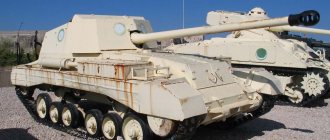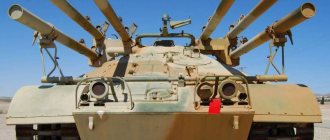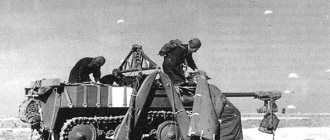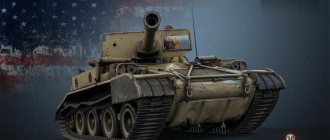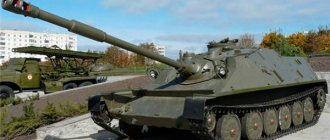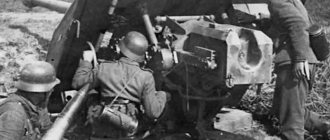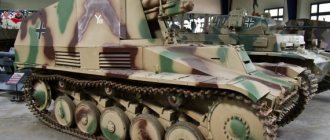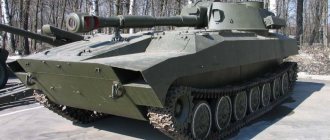Characteristics of the SU-76 self-propelled gun
A country:USSRType:self-propelled gunsDate of issue:1942Length:4.42 mWidth:2.47 mHeight:2.07 mArmor, forehead:35 mmArmor, side:15 mmArmor, tower:15 mmCrew:4 peopleEngine:GAZ-203, 140 hpTravel range:250 kmMaximum speed:45 km/hWeight:10.6 tWeapons:1x 76.2 mm ZIS-3 (60 rounds), 1x 7.62 mm DT machine gun
Advantages and disadvantages
Considering everything said above, we can say with confidence that our self-propelled anti-tank gun has a lot of strengths, but is not without certain weaknesses. To make it clearer for you, let's highlight the advantages and disadvantages of the SU-76I World of Tanks
separately. Pros: • Excellent frontal armor; • High camouflage coefficient; • Not a bad alpha strike; • Good rate of fire; • Sufficient armor penetration parameters; • Quick mixing; • Good mobility; • Preferential level of battles. Cons: • Weak armor on the sides and roof; • Large dimensions; • Poor visibility; • Uncomfortable UVN and UGN; • Mediocre accuracy.
History of the creation of the SU-76 self-propelled gun
The SU-76 self-propelled artillery mount was created in the USSR already during the Great Patriotic War and was the first full-fledged self-propelled gun of the Soviet Union - before the war, this young class of military equipment in our country was undeservedly deprived of attention. The first use of the new weapon took place in the late autumn of 1942.
Structurally, the SU-76 installation was built according to the “cheap and cheerful” scheme popular in those years, when the combat vehicle was created not taking into account what is best, but with an eye on what is in stock.
By the end of 1942, production of the T-70 light tank was already in decline (although in fact it had barely begun), so its chassis, mastered in production, served as the basis for the future self-propelled gun. The SU-76 was equipped with a reliable 76.2 mm ZIS-3 cannon, well known to artillerymen.
The resulting light self-propelled gun SU-76 was as simple as possible to manufacture, cheap, and easy to maintain. Maneuverable and passable, the SU-76, despite the weakness of the armor, could be used not only as an anti-tank weapon, but also go on the attack itself (and for a more powerful weapon, valued by infantry more than the T-70 tank) acting as a light tank or weapon direct fire support.
Also, although the creators of numerous games forget about this, the SU-76 could be used not only as a “linear” vehicle, but also fire from closed positions (the elevation angle of its gun was the largest among Soviet tanks and self-propelled guns during the war, 15°), covering targets at a distance of up to 13 km.
Production of the SU-76, which began in 1942, continued until 1945, with a total of 14,300 self-propelled guns produced.
Soviet self-propelled gun mount - SU-76
Stories about weapons. SU-76i: first attack
Continuing the theme of the USSR creating its own combat vehicles based on captured equipment, we decided to talk about another vehicle, which was created on the chassis of the German Pz.Kpfw.III tank.
A car that was produced in fairly small quantities, but still mass-produced. Alas, such machines have not been preserved in their original form in Russia. In Moscow, on Poklonnaya Hill there is a hybrid model. A real running and modern tower.
The only such machine that was actually produced during the Great Patriotic War and which participated in hostilities is located in the form of a monument on a pedestal in the Ukrainian city of Sarny. The car was found at the bottom of the river, raised and became a monument.
So, the hero of today’s story is the SU-76i self-propelled gun.
A car that is often unfairly criticized. A vehicle that was not inferior in firepower to the T-34 tank. A machine that was able to replace the completely Soviet SU-76 during modifications. A total of 201 SU-76i. But these are 201 heroes and 201 heroic crew.
We should start not with the history of creation, but with the name. The fact is that for most fans of Soviet technology, there are two self-propelled guns. SU-76i and SU-76(S-1). There are those who will say that there was another self-propelled gun - SU-76(T-III). Yes, all these cars were in the Red Army. But, in fact, this is one car. Just at different stages of development.
SU-76(T-III) is just an intermediate designation for a vehicle that was used at the beginning of the development of self-propelled guns. SU-S-1, in other documents SU-76(S-1) is the designation under which the vehicle was put into service. SU-76i is a modern name. The letter “and”, by the way, means “foreign”. We will use the modern designation self-propelled guns.
In the material about the self-propelled gun SG-122, we touched upon the topic of further developments by A. N. Kashtanov’s design bureau. Already during the development of the self-propelled howitzer, it became clear to designers that it would be problematic to use the chassis of the Pz.Kpfw.III tank without serious modifications to create heavy self-propelled guns. The same SG-122s were clearly overloaded in front. Which created a lot of problems for the crews.
Already in 1942, Kashtanov came up with a proposal to install a 76.2-mm ZiS-3Sh cannon on a German chassis. This is exactly the gun that was installed on the SU-76. In another option, it was proposed to use the F-22USV. Both options were good and bad in their own way. The guns were quite well constructed and had good firing properties. However, there was a drawback that made their use problematic.
Fastening the machine to the floor when aiming the gun both vertically and horizontally led to gaps appearing between the armor plate and the wheelhouse body. The crew was in danger of being hit not only by shells, but also by shrapnel and even small arms bullets.
Kashtanov also considered a classic solution - using a cabinet. But in this version, the fighting compartment was reduced, which led to a decrease in the ammunition load of the self-propelled guns. The “American” option of placing one of the crew members outside the vehicle during combat work was not even considered.
The best solution was to install the S-1 gun mount, which was developed at TsAKB based on the F-34. The gun was not mounted inside the wheelhouse, but on the front plate of the hull. For this purpose, the S-1 had a special gimbal frame. The vehicle took on the appearance of a familiar self-propelled gun. And installing the S-1 was not a problem for the designers.
1942 turned out to be a difficult year for the SU-76. Using machines for other purposes has led to huge losses. The vehicle was intended for direct infantry support. Agree, it is difficult for the SU-76 commander to object to the phrase of the rifle unit commander like “you have armor and a gun, but my soldiers have only heaven and earth for protection.” So the self-propelled guns were on fire, rolling out for direct fire against the tanks.
But there were especially many complaints and, to be honest, deaths, from two engines, which periodically became out of sync and disabled not only the power plant, but also the chassis. Moreover, this phenomenon was so frequent that the command of the Red Army demanded that the self-propelled guns be removed from the front and sent for revision.
That’s when the order for the development of Kashtanov appeared! Beginning of 1943. More precisely, on February 3, 1943, the People's Commissariat of Armaments issued an order to prepare mass production of an assault self-propelled gun at a captured base. Naturally, the development of the new self-propelled guns was entrusted to Kashtanov Design Bureau.
By this time, A. N. Kashtanov already had a full-fledged design bureau in Sverdlovsk. And two plants (No. 37 and No. 592), which were subordinated to the design bureau by the same order, significantly speeded up the work. And, as always, there was no time at all. The first prototype was needed on March 1st! It was necessary to remake 200 pieces of equipment! Alas, the prototype was completed only on March 6th. And on the same day his trials began.
The question of caliber often arises. Why such “mood swings” - from a 122 mm howitzer to a 76 mm gun? The answer, again, lies in the purpose of the vehicles and the availability of guns in the Red Army. The SG-122 showed that large-caliber guns are too heavy for this chassis. And it’s not the job of an infantry support vehicle to destroy tanks and fortifications. And for field guns, bunkers and machine gun nests, 76 mm was enough.
And we didn’t have a larger, for example, 85-mm gun. D-5 was just being tested. Although, in fairness, it should be noted that Kashtanov proposed immediately equipping the self-propelled guns with these very guns. To which I received a response (September 14, 1943) with a refusal. It was proposed to “freeze” the project for a while.
Let's take a closer look at the car. Externally, the SU-76i is very similar to the SG-122. However, upon closer examination, it becomes clear that the alterations were still significant. Even though the body has been practically preserved in its original form. Naturally, with the exception of the cut-off superstructure and tower. Therefore, we will not repeat ourselves.
Let's look at the conning tower. The cabin was assembled from sheets of rolled armor steel. The thickness of the sheets varied. Front - 35 mm, sides - 25 mm, stern and roof - 15 mm. Moreover, the upper armor plate was solid cast and was attached to the sides with bolts.
The crew of the vehicle had the opportunity to defend against enemy infantry using special holes on the forehead, in the sides and the left rear door of the wheelhouse. The openings for firing from PPSh (included in the self-propelled gun kit) were closed with special armored flaps. The upper double hatch could also be used for firing. In normal times, this hatch was used for boarding and disembarking the crew.
An interesting solution was found by the designers to increase the visibility of the crew. It is no secret that this point was a serious drawback of many Soviet self-propelled guns.
Let's start with the driver. Unlike other combat vehicles, the mechanic of the SU-76i looked not only forward, but also to the sides. The inspection hatches were located in such a way that the driver could see the road in the front triplex, and what was happening on the flanks in the side ones. Moreover, each triplex was protected from random bullets by a special armored barrier.
The crew in the control room also had the opportunity to inspect the area around them. Those very holes for firing from PPSh perfectly served as slits for inspecting the area. In addition, there was also a commander’s panorama of the PTK-5. In general, in terms of this indicator, the SU-76i was superior to other self-propelled guns of that period.
Now let's return to installation C-1. The designers, considering the GAZ reservation option, were dissatisfied with the complexity of this particular element of the S-1 design. The result of this dissatisfaction was a new cast mantlet, which allows the gun to be aimed within the range from -5 to +15 degrees vertically and +(-) 10 degrees horizontally. Here you simply cannot ignore the deadline for handing over the mask. The designers of plant No. 592 and UZTM developed and presented the mask in 5 (!) days.
With sighting equipment, the issue was resolved in much the same way. The designers adapted the TMFD-7 sight from the ZiS-3 field gun for the new vehicle.
The choice of weapon had its advantages. The SU could use almost the entire range of 76-mm tank shells. The SU-76i ammunition range included unitary rounds with a steel high-explosive long-range fragmentation grenade (OF-350, O-350A, F-354), an armor-piercing tracer projectile (BR-350A, BR-350B, BR-350SP), a cumulative projectile (BP-353A), sub-caliber armor-piercing tracer projectile (BR-354P), bullet shrapnel (Sh-354, Sh-354T and Sh-354G) and buckshot (Shch-350).
The SU had an impressive ammunition load, allowing it to fight for quite a long time without additional supplies. 96 shots for a cannon is significant. The placement of the ammunition was as follows: 48 rounds were located in the right rear corner of the wheelhouse on a horizontal rack, 38 in vertical racks along the left side and 10 in a vertical rack along the starboard side.
To protect the vehicle, the armament kit included two PPSh submachine guns (994 rounds of ammunition) and 25 F-1 grenades in pouches. And this is in addition to the crew’s personal weapons, that is, TT pistols. Quite enough for a short fight at close range.
The vehicle was put into service on March 20, 1943. And already at the beginning of May the first SU-76i were in service. Since that time, factories have stopped sending SU-76s to the active army. All machines were returned to the factories to eliminate identified deficiencies.
The assembly of self-propelled guns on a German chassis continued until November 1943 inclusive. In total, they managed to assemble 201 SU S-1. They were distributed by month as follows: March – 1; April – 25; May – 15; June – 20; July, August and September - 26 each; October and November – until 31.
Moreover, in August, out of 26 issued SUs, 20 were commander ones. The difference from conventional machines is the communication system. Command vehicles were equipped with more powerful radio stations.
How did the new cars fight? The story would be incomplete without combat episodes of the use of these control systems. But we will start not with Soviet documents, but with German ones. Document from the archives of the “Foreign Armies - East” directorate of the Abwehr army intelligence service. The report is dated October 25, 1943. The sender is the headquarters of the 1st Tank Army of the Wehrmacht.
“The 177th tank regiment of the 64th mechanized brigade has four companies of 11 vehicles each. These combat vehicles are designated Sturmgeschütz (assault gun) 76mm. They are made on the chassis of the German Panzer III tank with a Maybach engine. The new cabin has an armor thickness of 3-4 cm in the frontal part, and 1-1.5 cm on the sides. The cabin is open at the top. The gun has horizontal aiming angles of 15° in each direction and vertical aiming angles of ±7°.”
This is just about the SU-76i. More than once in German documents the SU-76i was compared in terms of efficiency with the T-34 tank. Agree, the comparison is more than honorable. In general, no wonder, since the vehicles were equal in firepower, since the gun was the same.
Soviet documents from that period are often quite difficult to examine. The fact is that combat vehicles were not divided by name. The SU-76 could be anything. The main thing is the caliber of the vehicle’s gun. However, there are reliable facts about the units that used the SU-76i. These are three self-propelled artillery regiments as part of the 5th Guards Tank Army - 1901st, 1902nd and 1903rd. The place where these vehicles fought is also known. South of Russia and north of Ukraine.
The participation of these self-propelled guns in the Battle of Kursk causes a lot of controversy. Alas, we could not find reliable facts about this. At least about the battle in the Prokhorovka area. There are also no references to such participation from other authors. Most likely, the Soviet command took into account the weak armor of these vehicles and did not consider them real opponents for German tanks and anti-tank missiles. By the way, this is precisely what subsequent events indicate. SUs were used more on the flanks.
Thus, the 13th Army of the Central Front, which defended the line in the Ponyri area, initially simply did not introduce the existing 16 SU-76i into battle. Even on the most difficult days for defense. These vehicles were in reserve. Exactly until the moment when the Germans broke through the defenses. This is where the SU-76s appeared at the turn.
We won’t talk about specific combat episodes. But the results for the SUs themselves are more than difficult. Of the 16 vehicles, exactly half were hit - 8 units. Of which 3 cars burned down.
It is interesting to read the combat reports from the already mentioned above 1902 glanders. The regiment arrived at the 5th Guards on August 2, 1943. The regiment included 15 SU-76i. The regiment received its first baptism of fire only 12 days later. The reason for this delay was the lack of vehicles to deliver ammunition and fuel. However, already on August 14, the regiment began to participate in battles.
Almost from August 14 to August 31, the regiment was constantly on the front line and participated in battles and skirmishes with the enemy. There were five serious battles. In the battles, the regiment destroyed two tanks, nine guns, 12 machine gun nests and up to 250 enemy soldiers.
On August 20, the Germans began to retreat. SU-76s began to pursue them. This is where the advantage of lighter SUs over tanks came into play. The speed of self-propelled guns was higher. As a result, six SU-76i destroyed three more tanks.
However, fierce battles, especially with tanks and self-propelled guns, knocked out self-propelled guns with very high intensity. Judging by the reports, the main losses of the self-propelled guns were suffered in September 1943. It was then that the vehicles began to be used for their intended purpose - to support the infantry. The vehicles were assigned to rifle regiments and battalions in quantities of 2-7 pieces. And they went on the attack against the German defense, which was saturated with PTS.
Be that as it may, these SU made their contribution to the overall victory over the enemy. Yes, they only fought for a year. But it was they who gave our engineers and designers time to eliminate the shortcomings of the SU-76 and equip our army with good vehicles. By the way, in terms of the number of units produced, the Su-76 occupies a solid second place (after the T-34). Soviet design.
The effectiveness of these self-propelled guns was truly great. In one of the sources we found such an interesting fact, the reliability of which we cannot vouch for, but... in one of the battles in 1944, our troops destroyed a German self-propelled gun. After inspection, it turned out to be an SU-76i! It turns out this car was a double trophy. First ours, then German. What doesn't happen in war...
Well, the traditional performance characteristics of the heroine, SU-76 and model 1943:
Weight: 22,500 kg. Crew: 4 people
Dimensions: Length: 6,900 mm. Width: 2,910 mm. Height: 2,375 mm. Ground clearance: 350 mm.
Armament: - 76.2 mm S-1 cannon, 96 rounds of ammunition. — 2 PPSh submachine guns, 994 ammunition (14 discs). — 25 F-1 grenades.
Armor: hull forehead: 30 mm. cutting edge: 35 mm. hull side: 30 mm. deckhouse side: 25 mm. stern, roof, bottom: 15 mm.
Engine: Maybach HL120TRM, 12-cylinder, liquid cooled, 300 hp. Speed: 50 km/h on the highway. Highway range: 180 km.
Overcoming obstacles: Climbing angle: 30°. Wall height: 1.00 m. Ford depth: 1.00 m. Ditch width: 2.10 m.
Design of self-propelled gun SU-76
The reinforced chassis of the T-70 light tank was used as the chassis of the SU-76 self-propelled gun. Due to the need to place a fairly large artillery system in a combat vehicle, the body of the original tank had to be lengthened, and then the chassis was lengthened - by one pair of road wheels (6 road wheels per side). In all other respects, the SU-76 hull repeated the T-70 hull.
The armor is bulletproof.
The 76-mm ZIS-3 cannon was mounted on a machine behind the armored shield of the wheelhouse (not the turret). Initially, the wheelhouse was completely covered with armor, but during the modernization associated with the transition to using the T-70M tank chassis, the armored roof was abandoned.
The vehicle commander was located in the conning tower to the right of the gun, the gunner to the left, and the loader to the rear.
The gun's anti-recoil devices are enclosed in an armored casing, which provides horizontal aiming angles of 15° to the left and right, and vertical aiming angles of 5° (declining) and 15° (elevation). The ammunition load includes 60 unitary rounds of various types, including sub-caliber ammunition. A trained SU-76 crew could fire 8-10 aimed shots per minute.
All SU-76 self-propelled guns were equipped with a transceiver radio station and a tank intercom.
Drawing of self-propelled gun SU-76
One can argue for a long time that a vehicle like the SU-76 with too light armor, and with an open conning tower on the battlefield, is nonsense, a “mass grave.” This opinion is quite common, although unprofessional. The armoring of the wheelhouse provides fairly reliable protection in the frontal projection, and if it hits the stern... it will destroy absolutely any vehicle. On the contrary, directly in battle, an open wheelhouse allows you to more effectively interact with infantry (which the SU-76 supports on the battlefield), remove powder gases without special devices, and if the vehicle is damaged, the crew can easily and quickly leave it.
At the same time, it is often overlooked that the relatively light and small “drying” was capable of burning almost any enemy tank - its shells penetrated the side armor of even heavy Pz V “Panthers,” not to mention earlier German vehicles. Of course, the SU-76 was practically powerless against the Pz VI Tiger, however, special vehicles also require special means of combating them.
Rear view of the SU-76
gun
As you can see, the general parameters of our tank destroyer really deserve respect, but the weapons will not disappoint you, it’s not for nothing that this tank is called an imba. So, the SU-76I gun
with a caliber of 76 millimeters, it has a good alpha strike for the third level and an enviable rate of fire, thanks to which we are able to inflict approximately 1535 units of pure damage per minute.
The armor penetration parameters of our gun are enough to comfortably fight both at the top and bottom of the list, which makes the SU-76I a World of Tank
s a very economical vehicle that practically does not require the use of gold shells.
With accuracy, things are a little worse, since we got a really large spread and weak stabilization, but these minor shortcomings are almost completely compensated for by fast mixing.
Finally, it remains to note that the weakest side of the SU-76I WoT
is the angles of vertical and horizontal aiming, the gun goes down only 5 degrees. Regarding the UGN, in total they amount to 20 degrees (10 in each direction).
Modifications and vehicles based on the SU-76
- SU-76 with parallel installation of GAZ-202 gasoline engines (70 hp) and an armored conning tower roof (320 vehicles were produced).
- SU-76M is a partially modernized self-propelled gun with an open top conning tower. The engines remained the same, but with increased service life.
- SU-76 is a reconfigured version of the self-propelled gun with a new twin installation of GAZ-203 engines (like the T-70), operating on a common shaft (140 hp in total). The most widespread modification, the engine was subsequently boosted to 170 hp.
- ZSU-37 is the first Soviet anti-aircraft self-propelled gun (37-mm automatic gun) created in 1945 on the basis of the SU-76. It was intended to protect tank columns on the march from air threats and was produced even after the production of the original self-propelled guns ceased.
Self-propelled gun SU-76
source: compilation based on materials from open sources on the Internet
Tactics for playing the SU-76I
As has already been said many times, we have a very strong tank in our hands, one might say imba, however, even such a machine will not play for you. You must remember her strengths and not forget about her shortcomings, trying to hide the latter.
But despite all of the above, tactics on the SU-76I
battle depends on one important factor - what kind of battle we find ourselves in. If we are talking about a battle at the top of the list, you can safely push the direction, that is, act aggressively.
To do this, you shouldn’t mindlessly rush forward; it’s better to move smoothly, stopping in advantageous places. For example, seeing World of Tanks on the SU-76I
1-3 opponents, it is better to stop at some stone, and having protected yourself from enemy artillery, deal with your opponents, only then continue moving. Otherwise, you may be boarded and quickly sent to the hangar.
If we are talking about battles against fourth levels, you need to act much more carefully. Yes, SU-76I tank
has excellent frontal armor, but only for its level, fours can penetrate us without any problems. Thus, it is better to take an advantageous position on the second line and work on allied light, fortunately, we have more than enough armor penetration.
For the rest, I will once again repeat a few common truths: we are very afraid of the artillery because of the cardboard roof, we cannot let anyone on board, and in battles against the 4th levels we need to behave very carefully. In other cases, tank destroyer SU-76I WoT
is capable of working miracles, giving its owner a lot of positive emotions and genuine fun from the game.
And finally, let me remind you - buy SU-76I
Now it’s impossible, it has long been withdrawn from free sale, but various promotions are possible during which it will be possible to purchase this imba, just be careful.
Other self-propelled guns
The WOT game, as mentioned earlier, claims to be as historic as possible. Therefore, here you can find game prototypes of real tanks. Soviet self-propelled guns are also quite popular here; some players love them and enjoy upgrading them.
Of course, all tank destroyers that are available in the USSR branch up to the sixth level are very weak in armor. Then the branch of self-propelled guns diverges. One offers gamers weak armor, but a powerful weapon, the second - strong armor, but an inaccurate gun.
The gaming brother of the now defunct SU-76I is the SU-76M. This tank destroyer is also available to players at the third level. It is very maneuverable, invisible, will be able to support allies, but is very “cardboard”. If you decide to upgrade this particular line, then it is worth noting that it is better to go into the bushes on this “drying”, otherwise you will have to go to the hangar ahead of time.
An ambush is the key to successful combat in almost any tank destroyer. Even if you took the powerful Object 704, do not think that the armored “forehead” gives you an advantage in an oncoming battle, and you need to immediately get into trouble. In fact, there will always be a firefly that will turn off the equipment or make it spin.
In general, in the game World of Tanks, Soviet self-propelled guns represent a very strong class. They can unexpectedly deal more than a thousand damage or tank all the damage received. Of course, these tanks also have their drawbacks. At high levels they, although heavily armored, are still very clumsy and slow. Nevertheless, in the right hands they can cause a lot of damage and pull fights out of the most hopeless pits.
Specifications
Elite equipment
Basic Balance weight: 5 Price: 1000 gold Durability: 160 HP Weight: 22,530 Vision: 300 m. Communication: 325 m.
Armament Ammunition: 98 pcs. Damage: 110 / 110 / 156 HP Penetration: 86 / 102 / 38 mm. Cooldown: 4.3 sec. Accuracy: 0.44 Aiming time: 2.1 VN angles: -5…+15° GN angles: -10…+10°
Reservation Case: 60 / 30 / 50 mm. Chance of fire: 2%
Mobility Power: 300 hp Speed: 50 / 14 km/h. Agility: 40 °/s Ground resistance: 1.1 / 1.5 / 2.5
Exploitation
As mentioned earlier, the SU-76I tank did not last long. In 1943 he was in reserve. 50 self-propelled guns could have taken part in the battle on the Kursk Bulge. But only the 13th Army, which defended the Ponyri area, had to use the SU. Moreover, if in the first days the self-propelled gun was not needed, then after the German troops broke through the defense line, the Soviet army began to use it. In defense, she lost several “dryers”, after which a regiment of 16 Soviet-German self-propelled guns was placed at her disposal.
The Voronezh Front also used the SU-76I, but, unfortunately, there is no exact data on the quantity and success of the operation of this equipment. Already in September, when the fighting moved to the north of Ukraine, self-propelled guns were used in somewhat unsuccessful practice, which affected their numbers and combat effectiveness. This happened due to the powerful equipment of the German troops with equipment.
Already in 1944, some regiments reorganized their composition with the old original “drying”, removing the modified one. The news about the Soviet self-propelled gun on a German chassis reached the Wehrmacht. The Germans assessed the combat effectiveness of self-propelled guns in comparison with the ST T-34. The only problem was with the booking. Later, information appeared that the Wehrmacht managed to capture a couple of samples of this “double trophy”, but nothing is known about the facts of its effective use.
At this moment, the world knows only two examples of the Soviet-German tank. One was found in the Sluch River. There, in the city of Sarny (Rivne region, Ukraine), it was installed as a monument. The second one was found and sent to one of the Moscow museums.
Combat effectiveness
The 76 mm gun has fairly high penetration and stable damage. “Drying” can boldly and faithfully advance to victory, demolishing opponents behind it, sending them to the hangar alone. Thanks to its high speed, the tank can quickly change flanks or successfully reach the base to protect it.
Despite the small reserve of “health”, the self-propelled gun has a lot of armor “in the forehead”, and therefore small-caliber tanks will not be able to penetrate it. In addition, we must not forget about land mines, which not only successfully disrupt capture, but can also perfectly shake a low-level tank.
